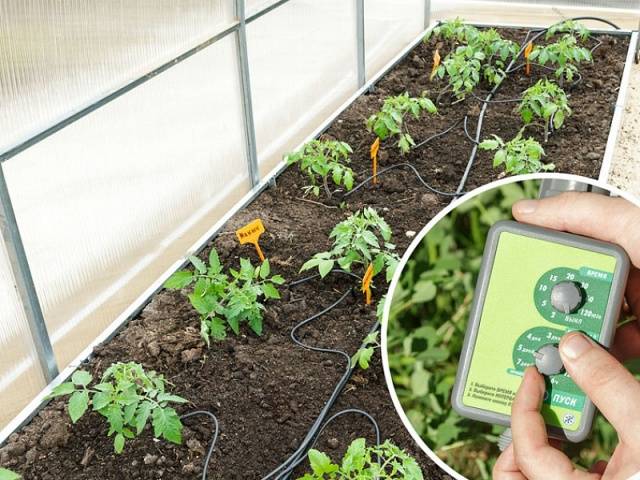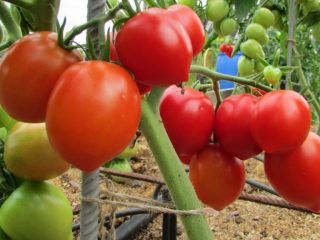Content
Tomato King of Siberia is the newest variety of tomatoes, which was bred by breeders of the Aelita agricultural company. It has not yet been patented in the State Register of Vegetable Crops; it is undergoing the testing stage, so there is little information about it. We took the description of the variety and its characteristics from very brief information published by the company on the official website. Amateur gardeners who have tested this tomato on their plots share their reviews on forums based on their own experience. Having combined all the meager data, we present you with a general overview of the varietal qualities of this tomato.
Description and characteristics of the variety
- The King of Siberia tomato is unlimited in growth, that is, it belongs to indeterminate crops. The height of the main stem can reach two or more meters.
- The ripening time of fruits is average; the duration of the growing season before the appearance of the first fruits varies from 100 to 115 days.
- The tomato variety King of Siberia is adapted for cultivation both in open ground (under film cover) and in greenhouses.
- The stems of tomatoes are strong, and clusters with 3-5 inflorescences are formed on them. It is necessary to install supports or trellises to form and tie up the bush. Mandatory removal of stepchildren is required.It is recommended to leave, along with the main stem, another branch that grows from the stepson under the first branch.
- The fruits are of an unusual orange color. This indicates a significant content of beta-carotene in tomatoes, which is necessary for human health. The weight of one tomato ranges from 300 to 400 g, but giant fruits weighing 700 and 1000 g have already been recorded. If you look at the photo of a cross-section of a tomato, it resembles the shape of a heart.
- Tomatoes of the King of Siberia variety are tasty, sweet, and contain many useful microelements and vitamins. People who are susceptible to allergic reactions when eating red fruits can safely add these tomatoes to their diet. It is recommended to use them in baby food and dietary dishes.
- The yield of King of Siberia tomatoes has not been established by official data, but on forums amateur gardeners determine it in quantities of up to 5 kg per bush, or up to 17 kg per 1 square meter. m plantation.
- Tomatoes are consumed fresh and used for winter preparations in salads and mixes.
Agrotechnics of cultivation
High yields of vegetables can be achieved only by observing all the requirements of technology, proper care and, if necessary, taking preventive measures against fungal diseases and control of harmful insects.
The King of Siberia tomato, like all cultivated varieties of tomatoes, has its own requirements for growing conditions:
- the soil should be light in composition, not contain large quantities of heavy components (clay), loose and well fertilized;
- before planting tomatoes, good predecessors will be: carrots, cabbage, legumes, onions and cucumbers;
- the first stage of growing tomatoes consists of sowing seeds (in March), picking them, fertilizing and hardening, that is, obtaining high-quality seedlings;
- the next stage is transplanting the seedlings into open ground under a film, which can be done in May (on the 60-65th day) with the onset of warm, fine days, into equipped heated greenhouses - already in April;
- Tomato seedlings are planted 3-4 bushes per 1 square meter. m of plantation, this norm is the same for open ground and greenhouses;
- tomato bushes are formed into 1-2 stems, leaving one stepson for the development of the second stem, the remaining stepsons are removed, not allowing them to grow more than 5 cm, so as not to seriously injure the plant;
- tall tomato seedlings are immediately tied to stakes, supports or trellises;
- The third, longest stage is caring for the plantings, but it is also the most enjoyable - we are waiting for the first fruits to appear and a full harvest.
Caring for tomatoes in open ground and greenhouses
The productivity of the King of Siberia tomato directly depends on the proper care of tomato seedlings. In open ground or in equipped greenhouses, tomato bushes will grow healthy and produce a good harvest if you follow basic care rules.
Soil requirements
- The soil in the area where tomato seedlings are planted should be loose, light in composition, and well-permeable to moisture and air. Add sand, ash, peat or lime to the clay substrate.
- The acidity of the soil for tomatoes is preferably neutral or slightly acidified; it should not be lower than 6.0 units on the acidity indicator scale. Acidic soils must be neutralized by adding deoxidizing elements to the soil: lime, humus, river sand.
- In areas with high groundwater levels, drainage must be done. A channel for draining groundwater or rainwater will prevent its accumulation at the roots of the plant, which has a detrimental effect on tomato bushes, causing rotting of the roots.
- The soil must be constantly loosened, providing free access of air and water to the roots of the plant, while removing weeds and larvae of harmful insects, already deposited by adults in the ground.
Correct watering regime
Watering in a greenhouse:
- morning is the best time of day for watering;
- the water must be warm, you need to arrange a place in the greenhouse and have a container for storing and warming water;
- tomatoes love root watering, and do not respond well to irrigation of the foliage;
- Watering in greenhouses is carried out no more than once a week;
- the amount of water depends on the size of the seedling: bushes just planted in the garden require 1 liter per bush, as growth increases, increase the dose to 5-10 liters per plant, maintaining this amount until fruiting begins;
- 2-3 weeks before the first fruits appear, watering must be significantly reduced so that the ovaries form faster; at this time, 1 liter of water per week will be enough for the plant, then the volume is increased again, but not excessively, otherwise the fruits may crack.
To prevent this, equip the greenhouse with normal drainage or a drip irrigation system.
Watering tomatoes growing in open ground is identical to the timing and volume of watering in greenhouses, except in cases where natural heavy rains take over this function. After such rains, there is no need to water the beds; postpone the procedure until the soil under the bushes is completely dry.
When and how to feed tomatoes
An important condition for obtaining a decent tomato harvest is timely, correct application of fertilizers, and regular fertilizing, which is combined with watering once a month. Basic complex fertilizers are applied in early spring 1-2 weeks before planting seedlings. Mineral fertilizers for tomatoes must include: phosphorus, potassium and nitrogen components.
Cattle manure is used as organic matter to fertilize tomatoes. horse or avian. The most common and accessible is cow manure; poultry and horse manure are used much less frequently; it is recommended for fertilizing plants in diluted form.
One matchbox of dry bird droppings is diluted in a 10-liter bucket, stirred, allowed to brew for a day, then 1 liter of this liquid is added to 5-6 liters of water.
Horse manure is much more effective than cow manure or diluted poultry manure, but it can only be obtained in certain areas where there are special horse farms.
Gardeners share their experiences
Gardeners are of the opinion that the real King of Siberia tomato variety has been lost, and numerous counterfeits are being sold. Here we have posted reviews from those gardeners who are sure that they have grown the King of Siberia.
Conclusion
The seeds of this newest tomato variety are difficult to obtain on the open market, but if you do it and grow a decent crop of King of Siberia tomato, you will be satisfied with the results of your labors.












